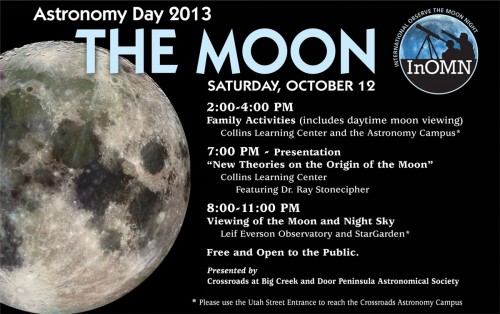Unless it rains on Saturday, Crossroads at Big Creek in collaboration with the Door Peninsula Astronomical Society will be observing “The Moon” on Astronomy Day 2013.
In doing so, we are participating in the International Observe the Moon Night which will be celebrated all over the world on October 12.
According to organizers, “International Observe the Moon Night (InOMN) is an annual event that is dedicated to encouraging people to ‘look up’ and take notice of our nearest neighbor, the Moon. From looking at the Moon with a naked eye to using the most sensitive telescope, every year on the same day, people from around the world hold events and activities that celebrate our Moon.”
The moon is worthy of celebration. We depend on it. Because of gravity, the Moon keeps the Earth from wobbling. The earth axis is tilted at 23 1/2 degrees. Consequently, it is not very stable. At least it wouldn’t be, except that the Moon holds it in place. But then, many scientists believe that the tilt was caused by the same celestial collision that created the Moon. (The origin of the Moon currently is being debated at astronomers.) Whatever cause it, the tilt is the reason for the seasons, and having regular seasons makes life on Earth possible.
The Moon exerts a significant a tug on the Earth, and that causes the tides. And the tides have a huge influence on animals. Some wonder if land animals would have evolved were it not for the tides.
Nocturnal animals depend on the Moon for a source of light for nighttime hunting. It’s probably not a cooincidence that breeding cycles of many species seem to coorelate with the phases of the Moon. Certainly human artists, poets, and romantics are inspired by the Moon.
Several people have asked: why this weekend? Why don’t we choose a weekend with a full moon? The asnwer is simple. The night of the full Moon is the worst time to observe our nearest neighbor. Admittedly, a full Moon is gorgeous, but seen through bioculars or a telescope, a full moon is so bright, it can hurt your eyes. [No permanent damage, but it is uncomfortable. If you’ve ever looked directly at a spotlight, you have an idea of how it feels.]
The other problem with viewing a full Moon is that everything looks flat. And the moon is covered with mountains, valleys, and craters and all kinds of interesting surface features. But when the Sun shines directly on the Moon, viewers on Earth see no shadows.
On the 12th if it is clear, the shadows….of the hills, of the “seas”, of the craters….will all be visible in glorious detail, and because the moon will rise about 2:35 PM, participants of Astronomy Day will be able to see the moon by day and also at night.
Family Activities are scheduled from 2:00-4:00 in the Collins Learning Center and at the Astronomy Campus. During the first hour, hands-on activities will help participants of all ages to see the moon in a different light. Beginning at about three, members of the Door Peninsula Astronomical Society will turn their telescopes on the Moon, and visitors can see the details of lunar geology. The Family Activities will be canceled in case of rain.
At 7:00, Saturday evening, rain or shine, Dr. Ray Stonecipher will present the lecture: “New Theories of the Origin of the Moon.” He will provide the most recent information and current theories about this controversial topic. This program will be held in the lecture hall of the Collins Learning Center. Following the lecture, if the sky is clear, members of DPAS will open the Observatory for night sky viewing. All activities are free and open to the public.


